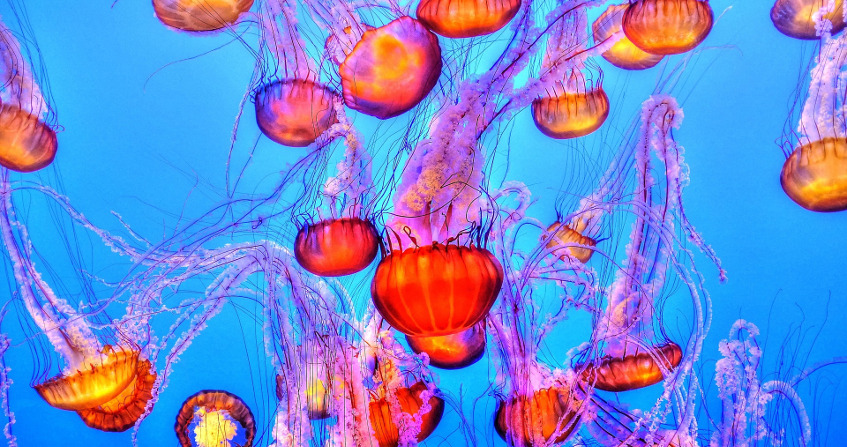缓慢而强大的大洋环流
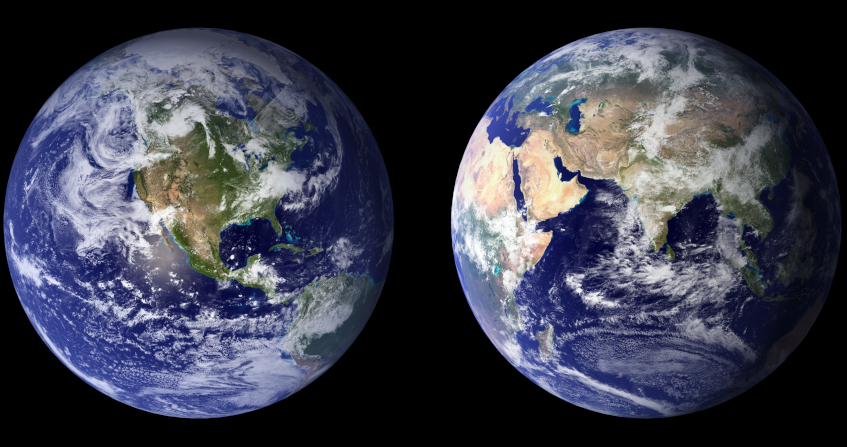
在海浪和潮汐的背后,隐藏着穿行于各大洋之间的强有力的洋流,阳光和吹过海面的风是它唯一的推动力,大陆是它不得不绕行的的屏障。变化的温度和盐度改变了海水的密度,进而重则下沉,轻则上浮。在这些因素的影响下,全球大洋环流会如何呈现?它的典型速度和循环周期是多少?它又是如何在不同的大洋、海域中产生次级环流的?
1. 什么是大洋环流?
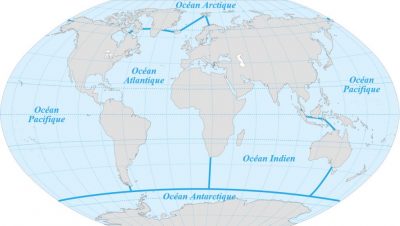
[来源:Pinpin / CC BY-SA (https://creativecommons.org/licenses/by-sa/3.0)]
海洋占据着地球表面72%的面积,这片广阔的区域早在35亿年前就萌发出生命(见“一位热爱天文学的地质学家眼中的生命起源”),并对整个地表环境产生了深远的影响。在大约两万年前开始的末次冰期到间冰期的过渡期内,平均海平面的变化量至少有120米。在此之前,英吉利海峡和北海还没有出现,我们的克鲁玛努人祖先可以从现在的欧洲大陆徒步走到那片后来成为不列颠群岛的土地上。在全新世(一万年前到现在),海洋的边界已经千年不曾改变,国际水文组织(IHO)[1]得以对其划分并命名。不过这种划分仍然有着很大的不确定性,对于栖息在大洋中的生物来说尤为如此。
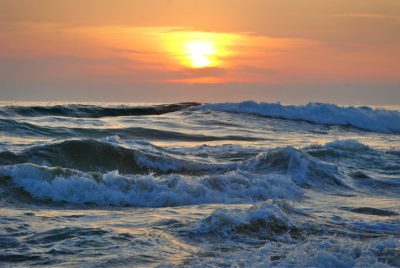
[来源:Royalty-free image]
我们所观察到的海面总是在不断的翻滚,或是骇人的涌浪和风浪,或是周期性涌入港口的海潮(见《潮汐》)。如果不考虑这些扰动,平均海平面非平非圆,而是坑坑洼洼、崎岖不平的:全球海平面最高的区域(格陵兰岛东南部)与海平面最低区域(印度南部)的高度相差达160米;单是地中海区域海平面高度差异就高达80米,其海平面最高值出现在巴利阿里群岛附近,最低值在克里特岛东南部(见《海洋环境》)。尽管从陆地上无法察觉,但海面之下的海水在五大洋之间缓慢却有力地循环流动着。海水的这种运动有一个特定的名称——热盐环流,即有赖于由温度和盐度[2]变化所导致的海水密度变化的运动。下文将对此进行详述。
2. 阳光——大气与水体运动的唯一引擎
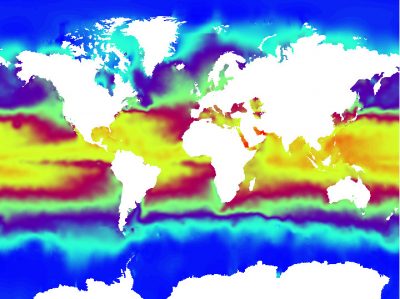
受太阳直射影响,温跃层以上海水温度提升(图3),在热带地区尤为明显,这推动了大气环流的产生(见“大气环流”)。进而产生的风,通过与海面的摩擦拖动海水,产生了缓慢却强有力的热盐环流。由此可见,阳光为大气和海洋这两种流体媒介提供了全部动能。
不过,大气和海水的环流有一个非常重要的不同之处,海水必须绕过海岸、浅水等障碍物,而信风(见“信风的重要作用”)、喷流(见“急流”)等主要大气运动则不受障碍影响。此外,由于密度的变化,表海水在冷却或盐度增加时变重下沉,反之则会上升,从而形成了海水运动的三维结构。
3. 赤道洋流
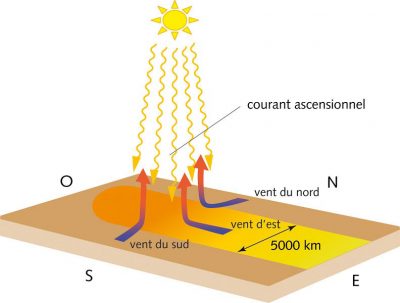
[来源:© EDPSciences, 已授权]
在春分点和秋分点,太阳直射赤道[3],南北半球的信风(图4)分别自南、北方向吹向赤道,在科氏力的作用下,这两股风在赤道交汇时产生向西的分量[4]。正是这股不是很快(风速约20千米/小时)但持续存在的东风,拉扯着海面向西流动,形成赤道洋流。
在春分点和秋分点之外的时节,如北半球的冬季,太阳直射点落在赤道偏南,南北半球的信风不再关于赤道对称,其交汇点随之相对赤道向南偏移。北半球的夏季则反之:在北半球的盛夏时节,太阳直射位于北纬23°26′的北回归线,这时信风交汇的位置也就落在北回归线上。而科氏力使信风在运动方向上偏右,因此这两股相向的信风在北半球交汇处形成了相反的水平分量(图5)。
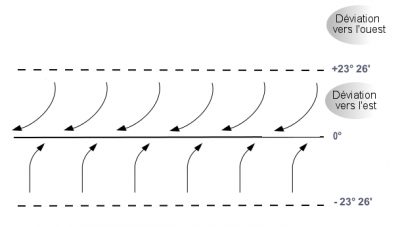
[来源:© Diane Gaillard]
科氏力在赤道为0,并且随纬度升高而增大。因此在北半球夏季,北风所受的科氏力较南风强,两者水平方向的分量以北风受科氏力产生的东风为大,因此总体风向仍旧指向西,对海水的拖拽作用也仍然向西,力量弱于三月和九月的情况。相似的不对称性也出现在北半球的冬季,此时太阳直射点在位于南纬23°26′的南回归线附近。这种由信风推动热带海水向西流动的现象同样属于赤道洋流。
总之,正是这股不强但持久的东风及其带来的赤道洋流,将哥伦布的多桅帆船送至委内瑞拉和西印度群岛。它们也为世界各地的高桅帆船比赛选手所熟知,虽然这风较弱,选手们仍然热衷扬起高高的船帆去捕捉它,以感受类似风暴带来的强大的推力。
4. 墨西哥湾流
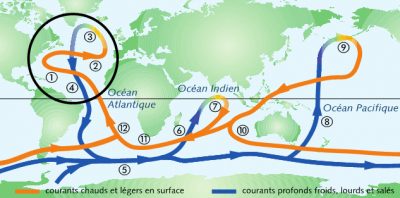
[来源:© EDP Sciences, 已授权]
让我们从大西洋看起,这里的水被风拖往北美海岸,其运动轨迹在科氏力的作用下有着指向其右侧的分量,也就是向北。这使得来自佛得角的表层海水向西北方的佛罗里达流去,并在陆地的阻挡下在佛罗里达附近海域积聚并产生高压,使海平面升高,急转向东流去,同时保持着向北运动的分量。这就形成了一个非常典型的热盐环流,称为墨西哥湾流(如图6a中①所示)。
由于所在的纬度没有信风,这股由高压产生的、自大西洋北美海岸流向欧洲的墨西哥湾流未有阻挡,温暖的洋流在抵达西班牙、法国和英国的同时(如图6a中②所示),也使伴随的空气层升温,大气以更快的速度向东运动。由此形成的主导西风受高纬度循环的极锋喷流影响,可能极强,也极不稳定。在洋流与气流的共同作用之下[5],尽管所处纬度相同,西欧国家的冬季气温高于北美国家。相似地,北欧海岸使洋流变向为西[6],在科氏力的作用下,向西北流向冰岛和格陵兰岛(如图6a中③所示)。
5. 墨西哥湾流的下沉及南归
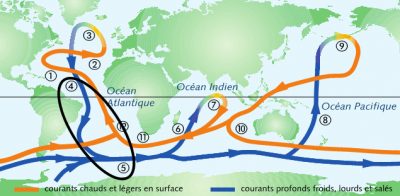
[来源:© EDP Sciences, with permission]
在北大西洋的第一阶段运动过程中,洋流一路从赤道到达格陵兰岛,由于蒸发作用,海水盐度逐渐升高。在海水向北移动中,随着纬度不断升高,其温度也不断降低。盐度的升高和温度的降低,共同导致了海水密度的增加。另外,由于盐在冰中的溶解度小于其在水中的溶解度[7],因此,海水中的大块浮冰在形成过程中析出盐分,进一步增加了海水的盐度。海水密度越来越大,到达一定程度后下沉,导致海洋表层洋流消失,转变为较深的一股又冷又重的洋流(如图6b中④所示)。
由于北冰洋较浅,这股洋流只能向南回流,它的密度能使其下沉到大西洋海底的海沟。大西洋在南半球海域宽阔,这股洋流一经抵达,在科氏力的作用下,运动方向向东偏移(如向非洲方向),即,由地球自转产生的科氏力决定了洋流向非洲大陆而非美洲大陆移动。之后洋流继续向南,受到南极大陆的阻挡,其轨迹最终变为由西向东(如图6b中⑤所示)。
6. 南归之后的洋流
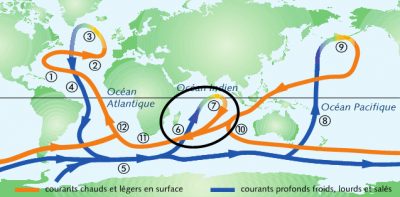
[来源:© EDP Sciences, 已授权]
当行至非洲大陆东侧,这股由于低温高盐导致其运行轨迹较深的洋流将向着三个可能的方向运动:北上进入印度洋,北上进入更远端的太平洋,以及继续向东环绕南极洲。环绕南极洲的洋流被称为南极绕极流;北上印度洋,向马达加斯加岛移动的部分称为莫桑比克暖流(如图6c中⑥所示),这股洋流在低纬热带地区逐渐升温,变轻上升到海表,最终受印度半岛的阻挡只能向南移动,并在科氏力的作用下偏西向运动(如图6c中⑦所示)。
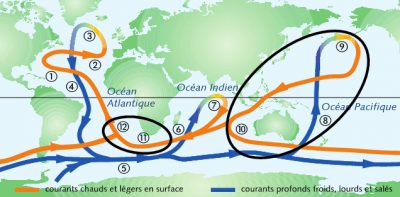
[来源:© EDP Sciences, 已授权]
北上太平洋的这股深层流(如图6d中⑧所示),首先向东绕过澳大利亚,再北上太平洋,形成了南赤道暖流、黑潮以及北赤道暖流。在穿越热带及温带的过程中,这股洋流逐渐升至海表(如图6d中⑨所示),受到白令海峡两侧的西伯利亚和阿拉斯加的阻挡,向西南方向折返。行至南半球,科氏力方向改变,导致其分成两部分,一部分东行(如图6d中⑩所示),完整地环绕南极洲;另一部分汇入印度洋环流(如图6d中11所示),向西行至非洲南部,最终在信风及赤道洋流共同作用下,汇入由南极向大西洋的洋流中(如图6中12所示)。
另一个鲜为人知的影响因素来自地球公转。地球以一个椭圆环的轨迹绕日公转,这个椭圆环的内外侧周长相差约80000千米。地球公转距离的差异对热盐环流产生了十分重要的影响。在惯性的加持下,热带地区地球绕日运动的速度差异可达约220千米/天(9千米/小时)。这一效应的方向与地球自转方向相反,因此,它成为赤道洋流的另一个推力,叠加在信风的作用中。
7. 次级洋流概述
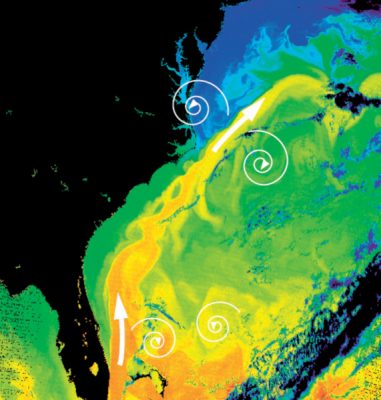
[来源:Donna Thomas / MODIS Ocean Group NASA / CFSG SST produced by R. Evans et al, U. Miami]. American 公开资源]
我们已经一步步了解了热盐环流。因为其强大的惯性和对气候的影响,以及对次级洋流的独特的作用,热盐环流被认为是最主要的大洋环流。文中的几张图片有利于我们理解其重要性。其中,最重要的无疑是其约1600年的循环周期[8]。它的速度最大约10千米/小时,但平均速度却小于1千米/小时,这主要归因于洋流与其周边海水形成的巨大涡旋的减速作用。
以墨西哥湾流为例(如图7所示),它是位于佛罗里达州和欧洲海岸之间的北大西洋的主要洋流,它就像是一条穿插在无数减速涡旋之间的、宽度超过100千米的大河。假设这条暖流仅浮在温跃层之上,那么它的深度约有50米,由此可以推知北大西洋的这条环流的海水输运量可以达到每小时数十亿立方米的量级。
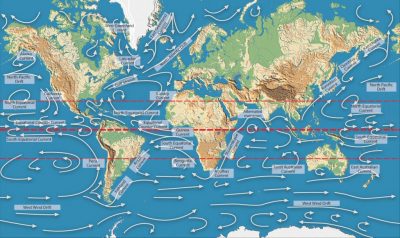
[来源:©Yuvanoe/AEC, 已授权]
在图6的基础上,图8展示出不同表层洋流的多样性,它们可看作是由于大陆阻挡和浅水作用而改道形成的。有些表层洋流极具代表性,例如洪堡德寒流,它是西风漂流的分支,受到南美洲西海岸阻挡而转而北上形成。洪堡德寒流对ENSO(厄尔尼诺-南方涛动现象)具有决定性的影响,控制着ENSO冷(拉尼娜现象)和暖(厄尔尼诺现象)的相位转换,这种转换的影响最远可波及欧洲。又如拉布拉多洋流,它发源于格陵兰岛,常将载有冰山的冷水带到加拿大东海岸附近,这也是北美大陆东海岸的冬季比纬度相当的西欧寒冷的原因。
不用深入地研究整套洋流系统,我们仅从图6和图8就可以看出海岸的重要性:阻碍环流移动、改变其方向并产生大量的次级环流。值得指出的是,海洋的某些部分是以其海岸形成的几何形状为特怔而加以区分的,例如加勒比海,它几乎被北边和西边的墨西哥湾以及东南边的加勒比群岛完整地包围住。
8. 大海——最广阔的自然保护区
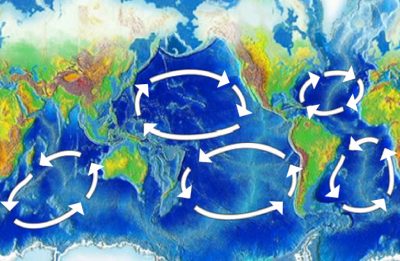
在读儒勒·凡尔纳[9]作品的同时,我们也要知道,不能将海洋简化为浩瀚的一池清水。河流和降水为海洋带来悬浮物质和碎屑。蒸发的淡水通过降水回到陆地或海洋,参与水循环过程。所有的这些物质,不论是矿物还是有机质,最终都汇聚到大海中,而大海也有着巨大的容量来容纳它们。这些物质中,一部分用于供养海洋动物和植物,而另一部分则积聚在海洋底部,形成沉积物,可能成为未来某个地质时代的大陆土壤。
漩涡可以通过向心力将塑料等比水轻的难降解物质聚集[10]。如今,科学家已经将这种现象记载在册(见《海洋中的塑料污染——第七大陆》),图9中着重标注了五大漩涡,上千吨塑料物质贮存其中,组成了人们所说的第七大陆。
即使是在最平静的情况下,大海也不是静止的,它被强大的海流切割,尤其是在热盐环流最深的部分,它甚至控制着所有其他环流。因为热盐环流速度缓慢,我们才可以用假静态去描述海洋环境,但同时,其输运的海流对大气循环、气象及气候的影响都是不容忽视的。

35亿多年前,海洋曾是生命的摇篮。在近30亿年的时间里,它是生命进化和多样化的唯一环境,直到某些物种设法通过向地球大气充氧来彻底地改变大气环境,然后迁移到陆地上并开发新的生存环境(见“拉马克和达尔文:两种对待生命世界的不同看法”)。这也表明,我们这个星球的生物多样性大部分在海洋环境中(图10)。据估计,海洋中的物种数量在500万至1000万之间,其中许多物种仍然未知。相比之下,陆地上的物种只有大约130万种,其中85万种是昆虫。
9. 知识点
- 热盐环流在各大洋之间穿行的速度是极低的,完整环流的周期约为1600年。即便如此,其运送的水量也是极其庞大的,这也使得热盐环流具有十分强大的惯性。
- 信风交汇产生了大西洋缓慢的赤道洋流,进而引发热盐环流。由于环流无法穿越美洲大陆,产生了北大西洋的墨西哥湾流。
- 在格陵兰岛附近,墨西哥湾流变重下沉,流经非洲和南极大陆,返回南半球。
- 南下的墨西哥湾流分出几个分支,其中两个分支分别北上印度洋和太平洋,过程中变轻上浮至表层,再因陆地的阻挡回流到大西洋,完成了闭合的巨大环流。
- 在各大洋中,表面洋流被涡旋减速。其中一些涡旋形成了漩涡,通过向心力聚集了大量的轻垃圾,如塑料垃圾。
- 作为最为稳定的要素,热盐环流和次级环流对气象及气候产生了巨大的影响。
参考资料及说明
图片封面:环绕着大地的辽阔海洋 [来源:Royalty Free Image]
[1] 国际水文测量组织,迷你维基网(https://fr.wikimini.org/wiki/Organisation_hydrographique_internationale).
[2] “haline”这个后缀起源于希腊单词alos(“αλ ο ο ζ, sel”)以及“alinos”(“salin”)。
[3] 来自拉丁语aequis(相等)和nox(夜晚)组成的aequis,用来定位白天和黑夜相等的日期。
[4] 由加斯帕德古斯塔夫·科里奥利(Gaspard Gustave Coriolis, 1792-1843)提出,这个力使我们能够以地球上的观察者为参考模拟运动,尽管它不是伽利略参考。由于地球绕着轴向正方向旋转,地球观察者看到所有不在这个方向上的物体的轨道都向相反的方向偏转。这种偏差在赤道为零,在两极最大,在北半球为右,在南半球为左。更多细节可以在我们的文章《大气环流》中找到(https://www.encyclopedie-environnement.org/en/air-en/atmospheric-circulation-organization/).
[5] 在西欧海岸和加拿大东部之间,在给定纬度10到15°C量级的冬季温差中,墨西哥湾暖流所占的份额要比急流引起的西向气流所占的份额大得多。
[6] 直布罗陀海峡太窄,吸收不了这一洋流的很大一部分。另一方面,英吉利海峡,就其规模而言,允许大量的水流渗透,从而产生诺曼底海岸的强潮汐。然而,就大西洋的规模而言,这样的流量仍然只是中等。
[7] 一般来说,当一种液体混合物固化时,溶剂和溶质这两种相总是可以区分的,这两种相在固态和液态时的溶解度是不一样的。这导致液相与溶质的富集,在文中的情况下,在带盐的浮冰附近的海水富集。
[8] 相比之下,像喷流这样的气流,其速度可达每小时300公里,只需几天就能绕地球一周 (见《喷流》一文(https://www.encyclopedie-environnement.org/en/air-en/jet-streams/))
[9] 海洋是大自然的巨大蓄水池,这是出自儒勒凡尔纳最著名的作品之一《海底两万里》的说法。这部小说于1869年至1870年以连载形式首次出版,是世界上翻译次数第五多的书,已被广泛改编成电影和电视。
[10] 在旋转流体微团中,离心力使较重的部分向外偏转;相反,向心力使较轻的部分向内偏转。
环境百科全书由环境和能源百科全书协会出版 (www.a3e.fr),该协会与格勒诺布尔阿尔卑斯大学和格勒诺布尔INP有合同关系,并由法国科学院赞助。
引用这篇文章: MOREAU René (2024年3月6日), 缓慢而强大的大洋环流, 环境百科全书,咨询于 2025年1月21日 [在线ISSN 2555-0950]网址: https://www.encyclopedie-environnement.org/zh/eau-zh/slow-powerful-ocean-circulation/.
环境百科全书中的文章是根据知识共享BY-NC-SA许可条款提供的,该许可授权复制的条件是:引用来源,不作商业使用,共享相同的初始条件,并且在每次重复使用或分发时复制知识共享BY-NC-SA许可声明。







